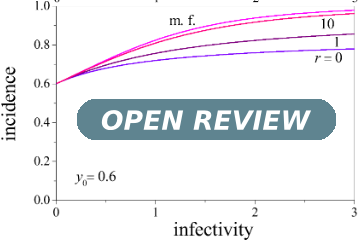SIR epidemics in monogamous populations with recombination
DOI:
https://doi.org/10.4279/pip.030001Keywords:
Epidemiological Models, Network Evolution, Self-organizationAbstract
We study the propagation of an SIR (susceptible--infectious--recovered) disease over an agent population which, at any instant, is fully divided into couples of agents. Couples are occasionally allowed to exchange their members. This process of couple recombination can compensate the instantaneous disconnection of the interaction pattern and thus allow for the propagation of the infection. We study the incidence of the disease as a function of its infectivity and of the recombination rate of couples, thus characterizing the interplay between the epidemic dynamics and the evolution of the population's interaction pattern.
Received: 12 August 2010, Accepted: 18 February 2011; Edited by: G. C. Barker; Reviewed by: B. Blasius, ICBM, University of Oldenburg, Germany; DOI: 10.4279/PIP.030001
Cite as: D. H. Zanette, Papers in Physics 3, 030001 (2011)

Downloads
Published
How to Cite
Issue
Section
License
Copyright (c) 2011 Damián H. Zanette

This work is licensed under a Creative Commons Attribution 4.0 International License.
Authors agree to the PIP Copyleft Notice













